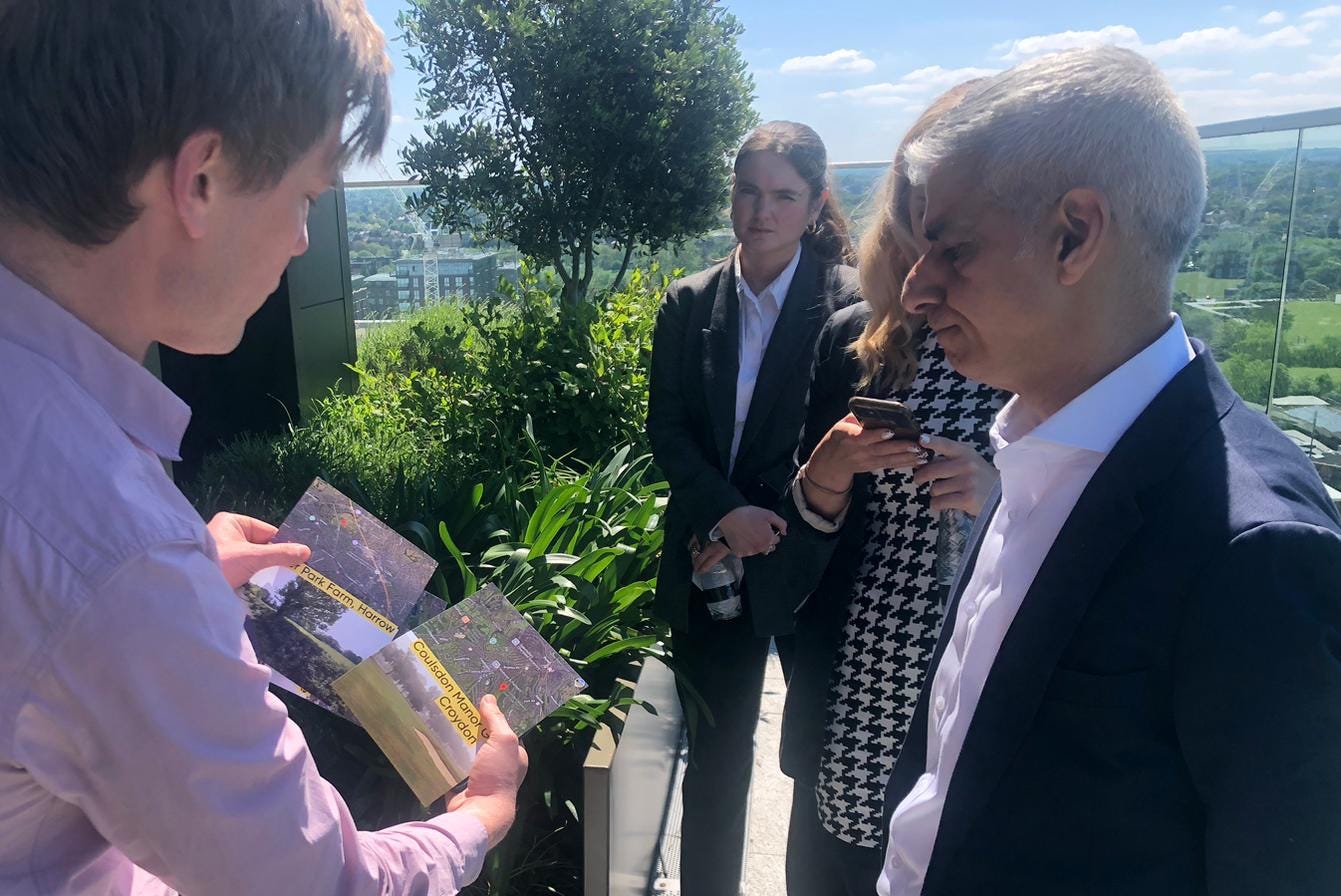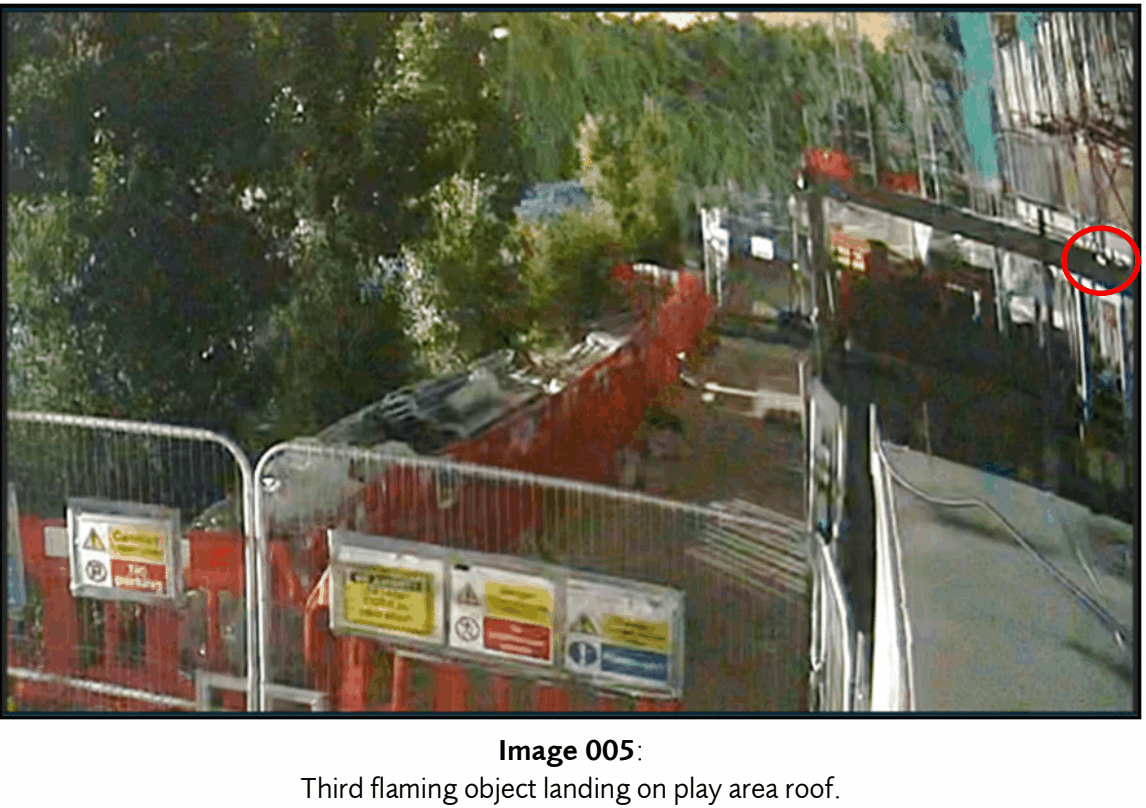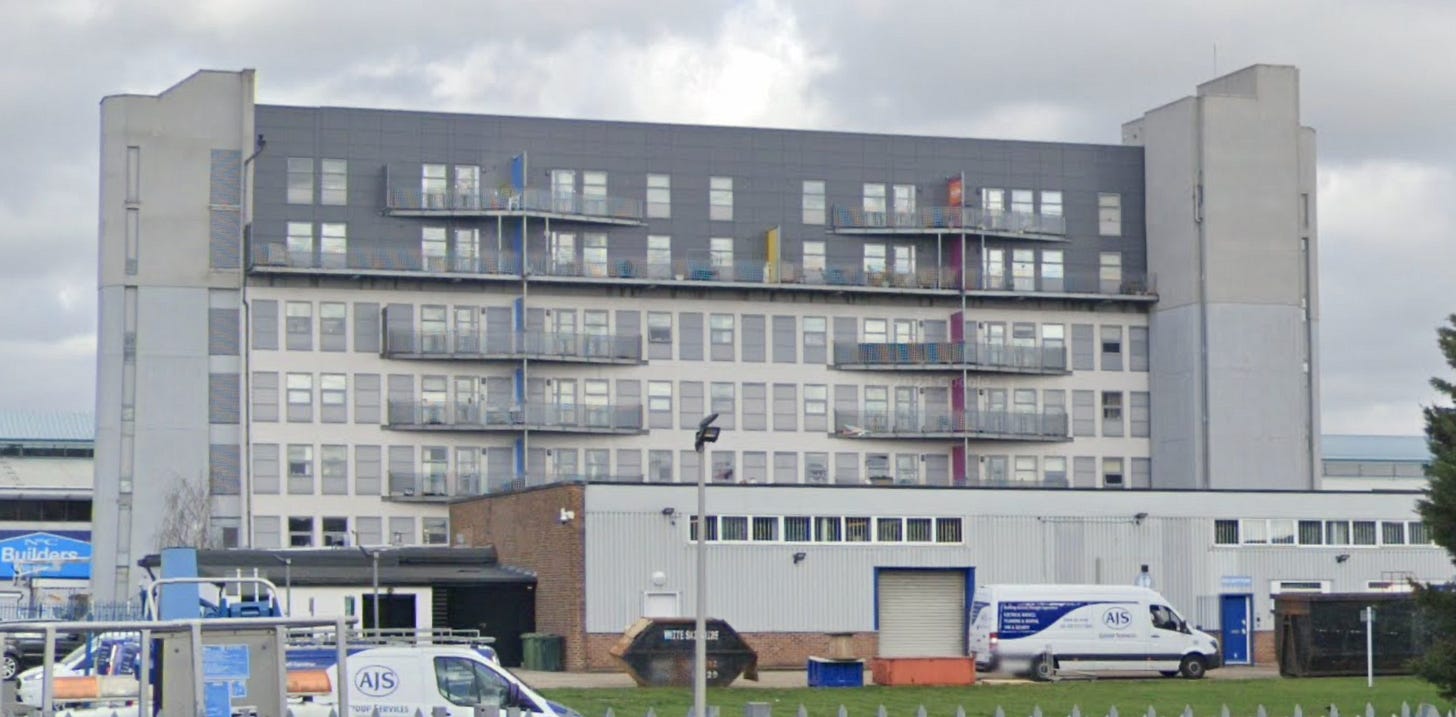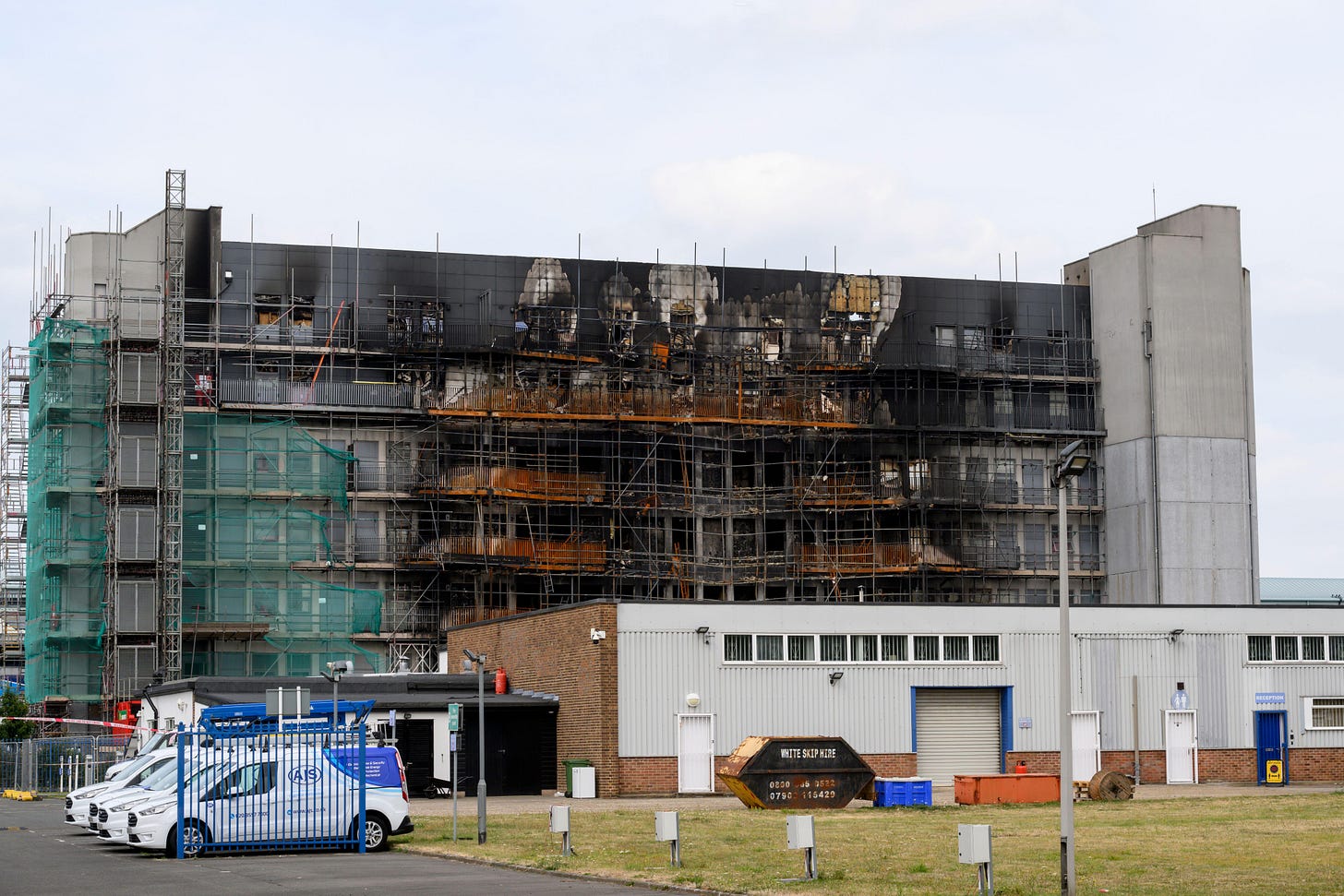A London fire disaster: the untold story
Plus: Sadiq Khan reassures London Centric readers that he doesn't want to build housing on their local park.
One thing London Centric will always do is return to the stories that other news outlets have moved on from. In a week when Sadiq Khan announced he had changed his mind on the need to build housing on Green Belt land to ease the capital’s housing crisis, we have obtained previously unseen internal reports and pictures that tell the story of one incident in which 80 Londoners lost their homes last summer.
The fire at Spectrum House in August 2024 was widely seen as the closest London has come to another Grenfell-type disaster in recent years. Due to quick action from the fire brigade all the residents were saved — and a relieved public and media quickly moved on. But how could a spark from a mysterious “flaming object” help create a fire that so quickly destroyed a whole building? Until recently, there has been lots of speculation but few facts.
Scroll down to read the main story.
Got a story that needs looking into? Get in touch with London Centric over email or WhatsApp.
Sadiq Khan wants to build houses on London’s Green Belt. Can we get him to say where?
Sadiq Khan headed to Kidbrooke Village in south east London on Friday to announce a U-turn. After almost a decade as mayor, during which he repeatedly insisted that all the homes London needs can be built on reused “brownfield” land, he’s flipped.
“I’m making a virtue of it, I’ve changed my mind,” Khan told London Centric.
He said Londoners need to get used to the idea of building housing on open fields near the edge of the city to meet demand. Parts of the Green Belt, the land protected from development since the 1950s to stop London sprawling into a Tokyo-style metropolis, are now up for grabs if they’re close to transport links into central London. (If you aren’t aware of the scale of the Green Belt, it’s worth looking at this interactive map.)
The challenge with selling this idea to the public is explaining exactly which parts of the Green Belt the mayor is happy to build on. As part of the consultation for the new London Plan, he says he’s targeting “low-quality land, poorly maintained and rarely enjoyed by Londoners”. But in the absence of firm examples, newspaper articles have been illustrated with images of picturesque villages. Understandably, Londoners reading Friday’s news coverage have raised concerns that their local beauty spot could be covered in housing.
London Centric showed the mayor three examples of Green Belt land close to transport connections that could fit his description: A farm in Harrow close to an Overground station, some open farmland in Redbridge, and a well-connected golf course in Croydon.

Are these the type of sites he’s looking at?
“You’re in danger of pre-judging the consultation,” he said. “What’s important is to reassure your readers that no one’s thinking of touching their gorgeous parks.”
Instead, Khan said the change is necessary to ensure families can still afford to have children in London, young professionals aren’t stuck living at home with their parents for years, and families aren’t stuck in unfit accommodation.
So why didn’t he seek this policy change when first elected back in 2016?
“We had a poor government then and we’ve got a good one now. I’ve got a government that is supporting the vision of meeting the needs of our city — and really critically, supporting transport infrastructure investment. You’ve seen, over the last nine years, an anti-London government.”
Part of this is the need to find land to build housing on the scale London requires and part of it is national politics. Khan, widely expected to be in his final term as mayor and not needing to face the electorate again, is able to take the political heat in the face of opposition from the Conservatives and Greens. At the same time the mayor is trying to convince central government to fund extensions of the Docklands Light Railway and Bakerloo lines. Tying the two together as a package could work for both Khan and the national government.
The really large potential development sites in the Green Belt sit outside the boundaries of Greater London itself, suggesting that where the capital leads Surrey, Hertfordshire, and Buckinghamshire could be forced to follow.
“Development on carefully-chosen bits of the Green Belt would allow us to unlock hundreds of thousands of homes,” said Khan, warning of a hollowed-out unaffordable London without dramatic action. “I ask Londoners whose gut instincts might be against this solution to look at the damage this housing crisis is doing.”
London Centric has been shortlisted for Private Eye’s Paul Foot Award due to our commitment to investigative journalism. If you aren’t already a paying subscriber and want to take a stand against clickbait while supporting proper local journalism about London, please consider joining now on our introductory 25% off offer.
What really happened at Spectrum House, London’s already-forgotten fire disaster?

By Rachel Rees and Jim Waterson
Kasia Stantke burst into tears when she heard a fire engine near her house two weeks ago. “It brings it all back”, she said, recalling memories of smoky corridors and people running for safety. “It’s still very traumatic.”
Eight months ago, Stantke’s previous home – a flat she rented in a converted office block on the edge of an east London industrial estate – went up in flames. The fire at Spectrum House in Dagenham took hold in the early hours of 26 August 2024, at the end of a hot Bank Holiday weekend, after three unknown flaming objects fell onto the flat roof of a nursery play area at the base of the residential building.

Exactly what those flaming objects were, their size, why they were on fire, and whether they were dropped by a human is not known.
What is known, however, is that the third of those small flaming objects is believed to have helped create a major fire attended by 40 fire engines – an event described by Charlie Pugsley, a deputy commissioner of the London Fire Brigade, as “one of the most extreme [fires] we have seen in a residential block in recent years”. Afterwards, the building was condemned and demolished.

Comparisons with the devastating Grenfell Tower fire, where 72 people died in 2017, were swift. Grenfell United, a group of survivors and bereaved families, said the Spectrum House fire was “a scenario we have warned about for seven years.” Claims swirled of known fire safety issues at Spectrum House: no fire alarm sounding on the night; terrified residents fleeing the flames to find their path blocked by a locked gate; and the building’s flammable, non-compliant cladding, in the process of being removed at the time of the fire.
For a brief moment it was the biggest news story in the country, as the public feared a repeat of the Grenfell tower disaster. Unlike Grenfell, all of the block’s 81 or so residents either escaped or were rescued by firefighters — albeit with the loss of their homes and everything they owned.
But London sees two high-rise fires a day, according to the fire brigade. Most don’t end with the entire building being demolished. What made the Dagenham fire so devastating?
London Centric has now obtained the full, unpublished internal London Fire Brigade report into the Spectrum House fire. The document addresses some questions, but it leaves a few crucial ones unanswered: Should people have been living there? How safe are high-rise blocks while building work is ongoing? And does the lack of casualties mean crucial lessons – with potentially devastating consequences – have failed to be learned?
“This was the only way we could afford a property in Greater London”
Spectrum House was a product of the capital’s broken housing market. Thanks to the opening of the Elizabeth Line it was located just half an hour on the train from Tottenham Court Road station. But culturally and mentally the block was a long way from central London.
Twenty years ago it was an office building on a major chemicals manufacturing complex run by DuPont, until the American business decided to cease manufacturing in London. As with many similar sites across the capital, rather than demolish the building and start again, the new owners decided to keep the factory’s 1970s concrete office block and convert it into flats, aimed at those who could not afford to live more centrally. Developers used a timber construction to add two extra floors to the roof and covered the extension in cladding.
Most of the residents rented from buy-to-let landlords, with tenants paying around £1,300 a month for a one-bedroom flat. Others were occupied by leaseholders who had queued overnight in 2016 for the chance to buy a rare affordable flat in the capital. By all accounts the block was pleasant enough to live in.
Then, after the Grenfell disaster, the cladding on the rooftop extension was deemed unsafe and in need of replacement to avoid the risk of a deadly fire. Like thousands of other Londoners, the residents found themselves paying to live in a property with known safety issues, waiting for a fix to be found for their “unsafe, unsellable flats”.
“This was the only way we could afford a property in Greater London”, the leaseholders told a 2022 parliamentary inquiry into the Grenfell disaster, two years before their own property would burn down. “The flats are in the cheapest borough in London. We had little choice of which property to purchase then – and we have no choice but to own it now.”
Last year the scaffolding finally went up to remove the flammable cladding. Instead, as the internal fire brigade report found, this would introduce a new fire risk: the timber slats on the scaffolding, which were bone dry after weeks of warm weather.
“Watching everything burn”
No building-wide alarm went off on the night of the fire, recalled Stantke, the former resident. Instead, as the fire brigade’s internal investigation confirmed, a Spectrum resident first spotted the flames shortly after 2.40am and phoned 999. From there, escalation was swift.
Six minutes after the call, the first of five fire engines arrived. Eight minutes later, the number of fire engines called out was upgraded to 10. After another five minutes this became 20. An hour after the initial call, at 3:42am, 40 fire engines had been called to the scene and a major incident had been declared.
A quarter of Spectrum House’s residents had to be rescued by firefighters wearing breathing apparatus. Two of them were given smoke hoods to provide 15 minutes of clean air; they had to be led over a security fence with a ladder. The rest of the block’s residents, including Stantke, escaped independently. In a major policy change which followed the Grenfell fire, residents were told to evacuate rather than stay in their flats and await rescue.

“I remember everything as if it was yesterday,” Stantke said. Woken by a noise outside, she “opened [her] eyes and it was orange”. She looked through the window, and saw flames approaching her flat’s balcony. She woke her partner, grabbed her shoes and their dog, and ran outside, “banging on doors” to alert neighbours. After finding their initial escape route padlocked, they ran “through the thick smoke”, eventually making it to the safety of a carpark across the street, “watching everything burn”. The next day, “we realised how close it was”, she added.
She was not the only resident to find her exit route blocked, with video footage from the night showing multiple residents coming up against a locked gate. This had been one of the issues previously noted by the fire brigade in a 2023 enforcement notice against building management company Block Management UK, which cited the lack of “adequate and clearly indicated emergency routes” among other fire safety failures.
More than eight hours after the initial emergency call, the major incident was declared over. Even then, “the building was still smoking” for around three days, according to Aklima Rahmin, a local resident on a neighbouring street.
Although all the residents survived, their homes did not. The block was demolished in December, after being declared unsafe due to the level of destruction caused by the fire. The roof had partially collapsed, while more than 80% of the top two floors and 60% of the rest of the building was damaged. A visit to the site in April found just a pile of rubble, with a couple of barely visible stairs being one of the few signs that it was once a place people lived.
“Unknown flaming objects”
The cause of the Spectrum House fire – including whether it was started deliberately or accidentally – remains unknown due to a lack of evidence even following the fire brigade’s investigation.
What is now clear, however, is that the first appearance of fire came long before the first resident spotted it. More than an hour before the first emergency call, the first of three “unknown flaming objects” fell from above and fizzled out on the nursery play area roof. Fifteen minutes later, it was joined by a second flaming item falling from above, which also fizzled out.
The third time a flaming object fell from above, at 2:19am, it fell off the flat roof and landed beside a wheelie bin used to store cardboard. Just over ten minutes later, CCTV captured a small fire on top of the bin. Fifteen minutes later, the play area was alight, with a CCTV still featured in the report showing a plastic slide melting in the flames. Another image, taken after the fire, showed the play area reduced to rubble and ashes.
Above this area, residents had balconies which protruded from the scaffolding. Previously unreported planning documents, seen by London Centric, show there had been longstanding concerns about “residents from apartments above … dropping litter into the [nursery] play area”. Yet residents said the balconies were locked off during the work to replace the cladding and there is no evidence that the flaming objects fell, either accidentally or deliberately, from the flats or their balconies.
“An accidental ignition… via the unsafe disposal of smoking materials is considered possible, but unlikely”, said the fire brigade report, declining to speculate further due to lack of evidence.
“I don’t think people should live in these buildings”
“I don’t really care how the fire started”, Stantke, the former resident, told London Centric. “My main question is how it spread so quickly”, she said, asking “how it got to the point that everyone lost everything.”
In 2022 Spectrum House residents told parliament they had been fighting for their property to be made safe: “The stress on leaseholders living in unsafe, unsellable flats with increasing service charges for well over three years is considerable.”
In February 2024, work finally began on the removal and replacement of this non-compliant cladding. The internal fire brigade report found this work had almost been completed. Instead, they concluded, it was the scaffolding put in place to remove the cladding that “assisted the fire's spread up the building"
With hundreds of buildings around London having flammable cladding replaced, Stantke said she didn’t think people should live in these buildings during renovation works.
“This is not the first time, and, I’m sure, not the last time”
More than eight months on from the fire, one household still remains in temporary accommodation, said Barking and Dagenham council, which offered emergency shelter and other support to the displaced householders in the wake of the fire.
All the former residents of the building say they are finding few answers and little accountability.
They have heard nothing from building owner Arinium Limited and received just one email from the building management, Block Management UK, saying that “they had fulfilled their obligation to us and had nothing more to say”, Stantke said.
Neither company responded to requests for comment.
The fire brigade’s inconclusive report also offers little in the way of clarity, said Christian Hansen, a solicitor at Bindmans who represents the residents. “The residents are grateful to the [London Fire Brigade] for their sterling work on the night and afterwards,” he said, but “they’re still left incredibly frustrated and frankly angry, and justifiably so, at the system that we’ve got.”
The Health and Safety Executive is continuing to make its own enquiries into the fire but Hansen accused the building freeholder and insurer Aviva of “keeping information to themselves” in private investigations. Aviva said they were “not aware of any information that Aviva has that the London Fire Brigade does not already have”.
Hansen added: “This is a systemic problem, really – in any fire, residents are going to face a similar situation.” He said building owners are not required to share information with residents or the fire brigade except for investigations relating to regulatory or criminal liability.
The lack of fatalities in the Spectrum House fire, while clearly a huge relief, means that the disaster hasn’t captured the attention or outrage of Londoners. But, as with the fatal cladding fire at Lakanal House in Camberwell, eight years before the Grenfell disaster, there is a danger that lessons could go unlearned.
In August 2024, the Grenfell United group of survivors and bereaved families said of Spectrum House that “the fact that when a fire happens and the best we can hope for at the moment is ‘a near miss’, speaks volumes of the progress made since 14 June 2017”.
Stantke reiterated this, saying she hoped that other building owners and companies would learn from the fate of her former home at Spectrum House. “It needs to be talked about,” she declared. “This is not the first time, and, I’m sure, not the last time”.
Please forward this edition of London Centric to a friend, get in touch via email or WhatsApp, or leave a comment.
Not already a London Centric subscriber? Please consider joining now on our introductory 25% off offer and help fund our journalism.





As high-rise buildings now come under the new Building Safety Regulator I expect that to improve matters, as even building control applications that would previously have gone to the local authority now go to the BSR to be considered, and works inspected by them. I'm not surprised that the building's block managers were so useless, the industry urgently needs proper regulation so these firms can be held to account for their failings rather than just shrugging when things go seriously wrong. If the leaseholders had control of the building they would have known everything that was happening on site, so stronger rights for leaseholders to seize control of their buildings from the likes of Aviva will also help reduce risks.
I enjoyed the article.
One quibble with the following: "As with many similar sites across the capital, rather than demolish the building and start again, the new owners decided to keep the factory’s 1970s concrete office block and convert it into flats, aimed at those who could not afford to live more centrally".
Planning policy incentivises owners to try to repurpose manifestly unsuitable buildings rather than knock them down and start again. If we had a better, more permissive planning system along the lines that Labour are proposing, I am not sure the owners would have retained the 1970s building.